Papers by Goksen Yaralioglu
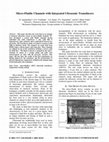
2001 IEEE Ultrasonics Symposium. Proceedings. An International Symposium (Cat. No.01CH37263), 2001
This paper describes the work done in an attempt to integrate ultrasonic sensors in micro-fluidic... more This paper describes the work done in an attempt to integrate ultrasonic sensors in micro-fluidic channels. We have developed a system with fluidic channels having embedded zinc oxide transducers. A zinc oxide film is deposited on a glass substrate and is sandwiched between two electrodes. The transducers made are found to resonate at 400 MHz in thickness mode. The channels are made both from PDMS using a silicon master and from glass. These channels are aligned on top of the transducer forming a narrow path for fluid flow. The fluid of interest is pumped in the microchannels by means of a syringe pump and pulse echo measurements are done with the necessary circuitry. This paper will also show the results of the first experiments on mixing induced by the transducer and the measurement of physical dimensions, temperature of fluid in the channel using broad band pulse echo techniques.

MEMS/NEMS, 2006
ABSTRACT Ultrasound is an imaging tool with a broad range of applications such as medical diagnos... more ABSTRACT Ultrasound is an imaging tool with a broad range of applications such as medical diagnostics, underwater exploration and nondestructive evaluation of materials. As early as the first half of the 19th century, sound waves had been used for underwater navigation and ranging. However, the history of modern acoustics began with the establishment of the theory of sound by Lord Rayleigh, and the discovery of piezoelectric effect by the Curie brothers, both in the late 1800s. Acoustical devices have been used for practical underwater imaging applications since World War I. Use of ultrasound in medicine started in the 1930s, and initially was confined to therapy, particularly in tissue heating. The first use of ultrasound as a medical diagnostic tool was for transmission imaging of brain tumors in the early 1940s. In the following years, sonic energy reflection from within soft tissue histological elements was reported, pioneering pulse-echo ultrasound imaging. Linear transducer arrays with electronic scanning started replacing fixed-focus mechanical sector scanners in the 1970s, providing greatly improved resolution and faster image formation. The details of the history of ultrasound imaging and transducer technologies can be found in several books [1, 2] and papers [3]–[6].
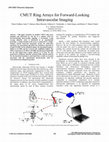
IEEE Ultrasonics Symposium, 2004, 2004
This paper describes an annular CMUT ring array designed and fabricated for the tip of a catheter... more This paper describes an annular CMUT ring array designed and fabricated for the tip of a catheter used for forward-looking intravascular imaging. A 64-element, 2-mm average diameter array is fabricated as an experimental prototype. A single element in the array is connected to a singlechannel custom front-end integrated circuit for pulse-echo operation. In conventional operation the transducer operated at around 10 MHz. In the collapsed regime, the operating frequency shifted to 25 MHz and the received echo amplitude tripled. The SNR is measured as 23 dB in a 50-MHz measurement bandwidth for an echo signal from a plane reflector at 1.5 mm. We also performed a nonlinear dynamic transient finite element analysis for the described transducer, and found these results are in good agreement with the experimental measurements, both for conventional and collapsed operation.
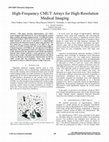
IEEE Ultrasonics Symposium, 2004, 2004
This paper describes high-frequency 1-D CMUT arrays designed and fabricated for use in electronic... more This paper describes high-frequency 1-D CMUT arrays designed and fabricated for use in electronically scanned high-resolution ultrasonic imaging systems. Two different designs of 64-element linear CMUT arrays are presented in this paper. A single element in each array is connected to a single-channel custom front-end integrated circuit for pulse-echo operation. The first design has a resonant frequency of 43 MHz in air, and operates at 30 MHz in immersion. The second design exhibits a resonant frequency of 60 MHz in air, and operates at 45 MHz in immersion. The experimental results are compared to simulation results obtained from the equivalent circuit model and nonlinear dynamic finite element analysis; a good agreement is observed between these results. This paper also briefly discusses the effects of the area fill factor on the frequency characteristics of CMUTs, which reveals that the transducer active area should be maximized to obtain a wideband response at high frequencies.
SPIE Newsroom, 2006
For many medical applications, real-time 3D images would allow a complete view of internal struct... more For many medical applications, real-time 3D images would allow a complete view of internal structures and an accurate assessment of volumes. In 3D sonography, for example, diagnostic interpretations would become less operator dependent because arbitrary cross-sections could be extracted from volume images. The determination of disease mechanisms would also be eased: real-time 3D images could provide simultaneous structural and functional information, such as the structure of blood vessels and their oxygenation levels. A suitable imaging system in this case might combine ultrasonic reflection-mode imaging (which maps mechanical properties using sound-wave reflections) with photoacoustic imaging (which infers oxygenation levels using the optical absorption image made from sound waves generated by the absorption of laser pulses).
Sensors and Actuators A: Physical, 2004
... This illustrates a potential additional advantage of higher-harmonic imaging: Surfaces with l... more ... This illustrates a potential additional advantage of higher-harmonic imaging: Surfaces with large topographical differences can be imaged with better resolution than in standard TM-AFM. 5. Conclusion. ... [10] M. Stark, RW Stark, WM Heckl and R. Guckenberger, Spectroscopy of ...
Sensors and Actuators A: Physical, 2005
In this work a new technology for designing and manufacturing ultrasonic interdigital transducers... more In this work a new technology for designing and manufacturing ultrasonic interdigital transducers (IDT) is presented. The piezoelectric material used is a metallised piezopolymer film made of polyvinylidene fluoride (PVDF) with electrode pattern obtained with a laser ablation process. Piezopolymer transducer prototypes are designed with wavelength of 8 mm to operate with Lamb waves (symmetrical S 0 mode). An experimental validation of the piezopolymer IDT design is demonstrated with a transmitter-receiver IDT pair embedded in a 3 mm thick carbon fiber reinforced plastic (CFRP) composite laminate.
Sensors and Actuators A: Physical, 2000
High-density through-wafer interconnects are incorporated in a two-dimensional 2D micromachined c... more High-density through-wafer interconnects are incorporated in a two-dimensional 2D micromachined cantilever array. The design addresses alignment and density issues associated with 2D arrays. Each cantilever has piezoresistive deflection sensors and high-aspect ratio silicon tips. The fabrication process and array operation are described. The integration of cantilevers, tips, and interconnects enables operation of a high-density 2D scanning probe array over large areas. q 2000 Elsevier Science S.A. All rights reserved. E.M. Chow . 0924-4247r00r$ -see front matter q 2000 Elsevier Science S.A. All rights reserved.

Journal of Micromechanics and Microengineering, 2007
The results of coating capacitive micromachined ultrasonic transducer (CMUT) arrays with two diff... more The results of coating capacitive micromachined ultrasonic transducer (CMUT) arrays with two different biocompatible materials, parylene-c and polydimethylsiloxane (PDMS), are reported. These materials were characterized for use with CMUTs to enable direct contact transcutaneous and in vivo imaging. A passivation coating is required to provide electrical isolation to the active areas of the device and to protect it from a corrosive environment. It must also provide good mechanical characteristics to void imaging artifacts. The coated devices were compared side by side with uncoated devices for testing in air. The resonant frequency, collapse voltage and crosstalk were sampled. Parylene coated CMUTs were also tested underwater using pulse excitation. The parylene coating provided electrical insulation to the aqueous solution for 14 days. Both coatings showed a decrease in device resonant frequency and an increase in collapse voltage, as expected from the proposed theory.
IEEE Transactions on Ultrasonics, Ferroelectrics and Frequency Control, 2000
The electromechanical coupling coefficient is an important figure of merit of ultrasonic transduc... more The electromechanical coupling coefficient is an important figure of merit of ultrasonic transducers. The transducer bandwidth is determined by the electromechanical coupling efficiency. The coupling coefficient is, hy definition, the ratio of delivered mechanical energy t o the stored opcratirig with an electrical input, the electromechanical conversion or coupling coefficient relates the amount of mechanical energy delivered to the load to the total energy in the device:

IEEE Transactions on Semiconductor Manufacturing, 2005
Direct deposition of photoresist and other spin-on materials, such as low-and high-dielectrics, h... more Direct deposition of photoresist and other spin-on materials, such as low-and high-dielectrics, has the potential to reduce waste as well as production costs. A new design of acoustically actuated two-dimensional (2-D) micromachined droplet ejector arrays can eject various solvents and other fluids ranging from femtoliter to picoliter droplet volumes. These ejectors do not harm fluids that are heat or pressure sensitive. Moreover, they are chemically compatible with the materials used in integrated circuit manufacturing. Therefore, they can be used for benign deposition of photoresist and other spin-on materials, such as low-and high-dielectrics. A vibrating circular Si N thin-film membrane with an orifice at the center forms the unit cell of a 2-D ejector array. Initially, one side of the membrane is loaded with the ejection fluid. Then, ultrasonic waves generated by a piezoelectric transducer force the membranes to displace at resonance. As a result of this actuation, droplets are ejected through the membrane orifice. We ejected water at 1.06 MHz, isopropanol at 1.14 MHz, ethyl alcohol at 1.06 MHz, and acetone at 1.04 MHz from a 20 20 single reservoir 2-D micromachined array with 160 m in diameter Si N membranes and 10 m in diameter orifices. The performance of single reservoir flextensional membrane-based ejector arrays was compared to flextensional membrane-based ejector arrays with reservoirs. A 50% decrease in the required power per ejected droplet and a reduced design complexity were demonstrated over the 2-D micromachined arrays with individual reservoirs. In addition, we deposited Shipley SPR 3612 photoresist at 1.12 MHz in a dry lab environment. No spinning was done after deposition. We covered a 2 2-mm area on a wafer with a 5.5-m thick photoresist layer. The maximum thickness variation over the area was 0.4 m. Moreover, we present a directly written 1.6-m thick 900-m wide and 8-mm long homogeneous photoresist line. The photoresist thickness variation along the line was 0.2 and 0.4 m in vertical and horizontal directions, respectively.
Applied Physics Letters, 1998
We present a 4 mm 2 image taken with a parallel array of 10 cantilevers, an image spanning 6.4 mm... more We present a 4 mm 2 image taken with a parallel array of 10 cantilevers, an image spanning 6.4 mm taken with 32 cantilevers, and lithography over a 100 mm 2 area using an array of 50 cantilevers. All of these results represent scan areas that are orders of magnitude larger than that of a typical atomic force microscope ͑0.01 mm 2 ). Previously, the serial nature and limited scan size of the atomic force microscope prevented large scale imaging. Our design addresses these issues by using a modular micromachined parallel atomic force microscope array in conjunction with large displacement scanners. High-resolution microscopy and lithography over large areas are important for many applications, but especially in microelectronics, where integrated circuit chips typically have nanometer scale features distributed over square centimeter areas.

ABSTRACT Capacitive micromachined ultrasonic transducers (CMUTs) offer several advantages such as... more ABSTRACT Capacitive micromachined ultrasonic transducers (CMUTs) offer several advantages such as wide bandwidth, high sensitivity and ease of fabrication over piezoelectric transducers. Recently, the CMUTs have emerged as an alternative technology in biomedical imaging applications. Consequently, the design and performance evaluation of CMUTs using finite element method (FEM) have become an important research field. This paper presents a method to compare, by means of a time-dependent simulation, transmission in the conventional, collapse-snapback and collapsed operation regime by a capacitive micromachined ultrasonic transducer (CMUT) using ANSYS 7.1. CMUTs were biased with a DC voltage and excited by an AC voltage. Depending on the amplitudes of these voltages relative to the device collapse and snapback voltages, they operated in the conventional, in the collapsed or in the collapse-snapback regimes. When the applied AC voltage was not negligible relative to the DC bias, it was not possible to fully characterize the dynamic behavior of a CMUT by performing harmonic analysis at the DC operating point. Instead, time- dependent analysis of the CMUT had to be performed by applying a time-varying voltage. We performed electrostatic and structural analyses sequentially to simulate the coupling between these domains. At each time step, the force on the membrane at the current membrane deformation due to the applied voltage was recalculated and this updated force was applied in the succeeding time step. A single membrane cell was immersed in a sphere of fluid to simulate the loading effect of water. The spherical boundary of the fluid was defined as an absorbing boundary to simulate an infinite medium. If the simulation time was prolonged, e.g. in order to model a steady-state response, the FLUID129 element, which used a second-order equation to approximate the absorbing boundary, became unstable. Furthermore, the approximate absorbing boundary required the radius of the surrounding sphere to be larger than 20 % of the largest wavelength of interest, which significantly increased computation time due to the large number of nodes in the model. We have implemented exact absorbing boundary conditions in our 2D axisymmetric model. This enabled us to have a highly efficient stable absorbing boundary and to reduce the radius of the fluid medium arbitrarily without loss of accuracy. Additional computation time due to the implementation of exact absorbing boundary is less than 10 % of the total computation time.
... Arif S. Ergun, Yongli Huang, Ching-H. Cheng, Ömer Oralkan, Jeremy Johnson ... and BT Khuri-Ya... more ... Arif S. Ergun, Yongli Huang, Ching-H. Cheng, Ömer Oralkan, Jeremy Johnson ... and BT Khuri-Yakub, A surface micromachined electrostatic ultrasonic air transducer, IEEE ... CH Mastrangelo, CH Hsu, Mechanical Stability and Adhesion of Microstructures Under Capillary Forces ...

The interdigital (ID) cantilever with two sets of interleaving fingers is an alternative to the c... more The interdigital (ID) cantilever with two sets of interleaving fingers is an alternative to the conventional cantilever used in the atomic force microscope (AFM). In this paper we present a detailed analysis of the interdigital cantilever and its use as a sensor for the AFM. In this study, we combine finite element analysis with diffraction theory to simulate the mechanically induced optical response of the ID. This model is used to compare this system with the optical lever detector as used in conventional instruments by analyzing the ratio of signal to noise and overall performance. We find that optical detection of the cantilever motion with interdigital fingers has two advantages. When used in conjunction with arrays of cantilevers it is far easier to align. More importantly, it is immune to laser pointing noise and thermally excited mechanical vibrations and this improves the sensitivity as compared to the optical lever.

Sensors and Actuators A-physical, 1999
In this paper we report on the microfabrication of a 5 = 5 2D cantilever array and its successful... more In this paper we report on the microfabrication of a 5 = 5 2D cantilever array and its successful application to parallel imaging. The 5 = 5 array with integrated force sensing and tip heating has been fabricated using a recently developed, all dry, silicon backside etching process. The levers on the array have integrated piezoresistive sensing, and are placed on a constriction in the lever to improve sensitivity. The array is scanned in x and y directions using voice coil actuators. Three additional voice coil z actuators are used in a triangular arrangement to approach the sample with the array chip. The system is thus leveled in the same way as an air table. We report details of the array fabrication, the x-y scanning and approach system as well as images taken with the system. The results are encouraging for the development of large-scale VLSI-Nano EMS, allowing the fabrication and operation of large AFM cantilever arrays to achieve high-data-rate Terabit storage systems. q 1999 Elsevier Science S.A. All rights reserved.

An expandable system has been developed to operate multiple probes for the atomic force microscop... more An expandable system has been developed to operate multiple probes for the atomic force microscope in parallel at high speeds. The combined improvements from parallelism and enhanced tip speed in this system represent an increase in throughput by over two orders of magnitude. A modular cantilever design has been replicated to produce an array of 50 cantilevers with a 200 m pitch. This design contains a dedicated integrated sensor and integrated actuator where the cells can be repeated indefinitely. Electrical shielding within the array virtually eliminates coupling between the actuators and sensors. The reduced coupling simplifies the control electronics, facilitating the design of a computer system to automate the parallel high-speed arrays. This automated system has been applied to four cantilevers within the array of 50 cantilevers, with a 20 kHz bandwidth and a noise level of less than 50 Å. For typical samples, this bandwidth allows us to scan the probes at 4 mm/s.

Equivalent circuit model has been widely used to predict the bandwidth of capacitive micromachine... more Equivalent circuit model has been widely used to predict the bandwidth of capacitive micromachined ultrasonic transducers (CMUTs). According to this model, the lower cutoff of the bandwidth is determined by the time constant of the parallel RC where R is dictated by the radiation and C is determined by the electrical capacitance of the transducer. The higher cutoff, on the other hand, is determined by the membrane's anti-resonance. In the mechanical part of the model, the radiation impedance is simply added to the membrane impedance assuming that the membrane impedance does not change when it operates in the immersion medium. Therefore, the mass loading effect of the medium is neglected. Our finite element method calculations showed that the mass loading on the membrane impedance drastically lowers the membrane anti-resonance frequency degrading the bandwidth. In this paper, we present results of equivalent circuit modeling combined with finite element analysis. We constructed a 3D finite element model for one element of a 1D array. The element has 7 hexagonal membranes in the width dimension and it is assumed that the membranes are replicated in the length dimension infinitely by using symmetry boundary conditions. By combining membrane impedance with equivalent circuit model, we found that the center frequency of operation is 11 MHz and the bandwidth is 12.5 MHz close to the collapse voltage. We also investigated the effect of the DC bias on the center frequency. Decreasing the bias voltage increased the center frequency without affecting the bandwidth assuming the source impedance is zero.
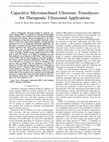
Journal of Aerospace Engineering, 2003
Therapeutic ultrasound guided by magnetic resonance imaging (MRI) is a noninvasive treatment that... more Therapeutic ultrasound guided by magnetic resonance imaging (MRI) is a noninvasive treatment that potentially reduces mortality, lowers medical costs, and widens accessibility of treatments for patients. Recent developments in the design and fabrication of capacitive micromachined ultrasonic transducers (CMUTs) have made them competitive with piezoelectric transducers for use in therapeutic ultrasound applications. In this paper, we present the first designs and prototypes of an 8element, concentric-ring, CMUT array to treat upper abdominal cancers. This array was simulated and designed to focus 30-50 mm into tissue and ablate a 2-3 cm diameter tumor within 1 hour. Assuming a surface acoustic output pressure of 1 MPa peak to peak (8.5 W/cm2) at 2.5 MHz, we simulated an array that produced a focal intensity of 680 W/cm 2 when focusing to 35 mm. CMUT cells were then designed to meet these frequency and surface acoustic intensity specifications. These cell designs were fabricated as 2.5 mm by 2.5 mm test transducers and used to verify our models. The test transducers were shown to operate at 2.5 MHz with an output pressure of 1.4 MPa peak to peak (16.3 W/cm 2 ). With this CMUT cell design, we fabricated a full 8-element array. Due to yield issues, we only developed electronics to focus the four center elements of the array. The beam profile of the measured array deviated from the simulated because of crosstalk effects; the beamwidth matched within 10% and sidelobes increased by 2 times, which caused the measured gain to be 16.6 compared to 27.4.
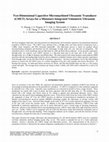
We have designed, fabricated, and characterized two-dimensional 16x16-element capacitive micromac... more We have designed, fabricated, and characterized two-dimensional 16x16-element capacitive micromachined ultrasonic transducer (CMUT) arrays. The CMUT array elements have a 250-µm pitch, and when tested in immersion, have a 5-MHz center frequency and 99% fractional bandwidth. The fabrication process is based on standard silicon micromachining techniques and therefore has the advantages of high yield, low cost, and ease of integration. The transducers have a Si 3 N 4 membrane and are fabricated on a 400-µm thick silicon substrate. A low parasitic capacitance through-wafer via connects each CMUT element to a flip-chip bond pad on the back side of the wafer. Each through-wafer via is 20 µ m in diameter and 400 µ m deep. The interconnects form metal-insulator-semiconductor (MIS) junctions with the surrounding high-resistivity silicon substrate to establish isolation and to reduce parasitic capacitance. Each through-wafer via has less than 0.06 pF of parasitic capacitance. We have investigated a Au-In flip-chip bonding process to connect the 2D CMUT array to a custom integrated circuit (IC) with transmit and receive electronics. To develop this process, we fabricated fanout structures on silicon, and flip-chip bonded these test dies to a flat surface coated with gold. The average series resistance per bump is about 3 Ohms, and 100% yield is obtained for a total of 30 bumps.





Uploads
Papers by Goksen Yaralioglu